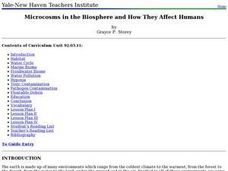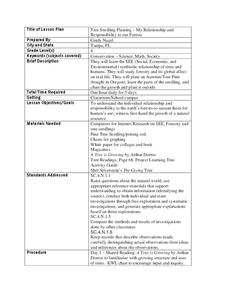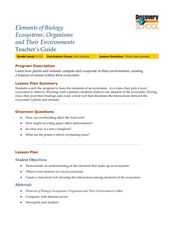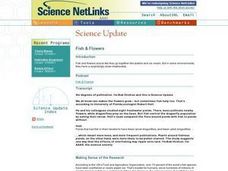Curated OER
Symbiotic Relationships
Offering a comprehensive overview of symbiotic relationships, this presentation would be a great way to introduce or review material covered in a biology class. There are definitions, examples, and a quiz on the meaning of parasitism,...
Curated OER
Friend, Foe, or . . .
As a result of this lesson, upper elementary ocean explorers will be able to describe several interrelationships: symbiosis, mutualism, commensalism, and parasitism. They learn that the biological richness is increased near seamounts and...
Curated OER
Bats, Bees, Birds, and Blossoms
Youngsters use a paper bee to pollinate two paper flowers. They use hole-punch dots as pollen. Older learners dissect flowers and name the structures involved in pollination. The handouts mentioned in the lesson plan are not included, so...
Curated OER
Ecology
For use early in the year with your ecology class, this collection of slides introduces viewers to cycles in nature and relationships between organisms. There is a food web diagram, but the presentation is incomplete without any diagrams...
Curated OER
CSI on the Deep Reef
After some instruction, small groups prepare a written report on chemotrophic organisms. Though not clearly mentioned, this resource would work best if groups have the Internet available to research the vocabulary and different organisms...
Curated OER
Science: Microcosms in the Biosphere
In a series of lessons, examine the impact on humans by microcosms in the biosphere. Among the plans structured for learners with different abilities and learning styles, are activities describing the symbiotic relationship, drawing the...
Curated OER
Symbiosis: Help, Hinder or Destroy
Use background information and vocabulary to familiarize your students with the concept of symbiosis and the role agriculture plays in the shared relationship. They then write the vocabulary in their lab books or journals, and read the...
Curated OER
Symbiosis and Co-evolution
By choosing a species and researching an adaptive symbiotic relationship it shares with another species, your students are able to investigate a symbiotic relationship in a lab setting. They create a presentation using a variety of...
Curated OER
Symbiotic Strategies
Students explore the different interspecies relationships namely mutualistic, commensal and parasitic. For this ecology lesson, students investigate an ecosystem disrupted by humans. They formulate an action plan to save it and present...
Curated OER
CSI on the Deep Reef
Students read about, discuss, and research chemotrophic organisms. In this chemosynthesis lesson, students discuss the differences between photosynthesis and chemosynthesis. They learn that chemosynthesis includes a variety of chemical...
Curated OER
Tree Seedling Planting- My Relationship and Responsibility to our Forests
In this trees lesson plan, 4th graders read the book, A Tree is Growing and complete a KWL chart on how trees grow and how they are used. Students research the symbiotic relationship of humans and trees, create tree collages, plant a...
Curated OER
Organisms and Their Environments
Students study a local ecosystem and research the organisms to create a food web. In this ecosystem lesson, students view a video and answer questions. They visit a local ecosystem and make a list of organisms to research. Students...
Curated OER
Alcoholic Fermentation Lab
In this alcohol fermentation worksheet, students design an apparatus to study the alcoholic fermentation of yeast. Once complete, students answer 8 short answer questions.
Curated OER
Activity 2: How Do You Get Your Energy?
Students receive informational handouts about photosynthesis, chemosynthesis and tubeworms (included with the lesson). Using the "Bacteriology Experiment Plan" handout, students compare the amount of bacteria found in two locations. They...
Curated OER
Nitrogen Fixation, OR What a Gas!
High schoolers gain skill in the design, implementation, and reporting of a scientific research project using the scientific method. They set up an experiment to determine the effect of adding the Rhizobium bacteria to one group of...
Curated OER
Fish and Flowers
Students read and discuss a research article that explains the unlikely link between increased fish populations and increased plant pollination. They answer reading guide questions to discover this ecological relationship.
Curated OER
Biological Relationships - Coral Reef Memory Game and Chain Game
Students familiarize themselves with the interconnectedness of species within an ecosystem, and to use this knowledge to evaluate how the removal or decimation of one species can have far reaching effects.
Curated OER
Bacteria: Friend or Foe?
Young scholars examine a variety of environmental and industrial roles of bacteria. explore where bacteria can be found and distinguish bacteria from other organisms.
Curated OER
Oysters Are Habit Forming!
Students examine the relationships within a salt marsh habitat. In this habitat lesson, students examine the various kinds of symbiotic relationships in a salt marsh habitat.
Curated OER
Mycorrhiza
Students examine the symbiotic relationship between fungus and plants. In this ecosystem instructional activity students complete several mycorrhiza experiments.
Curated OER
Body by Design: Form and Function
Students study symbiosis and its association in nature. In this organisms lesson plan students divide into groups and research organisms that have a symbiotic relationship.
Curated OER
Symbiotic Relationships
Seventh graders research types of symbiotic relationships on the Internet and explain what the effects would be in one of the species disappears. For this investigative lesson students use the Internet to do research then participate in...
Curated OER
Cool Corals
Students research questions pertaining to ecology and biology of shallow and deep water corals. In this investigative activity student get into groups and design questions that will expand their knowledge of corals.
Curated OER
Let's Make a Tubeworm!
Students discuss deep-sea chemosynthetic communities then create a poster of a three-dimensional tubeworm. In this creative lesson students create their own tubeworm and write a written report on it.

























